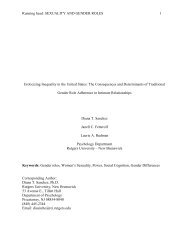Sources of self-categorization as minority for mixed race individuals
Sources of self-categorization as minority for mixed race individuals
Sources of self-categorization as minority for mixed race individuals
Create successful ePaper yourself
Turn your PDF publications into a flip-book with our unique Google optimized e-Paper software.
<strong>Sources</strong> <strong>of</strong> Self-Categorization 14confidence interval = .00 - .08). We there<strong>for</strong>e felt confident that the me<strong>as</strong>ures designed <strong>for</strong> thecurrent study, although related, represented distinct constructs.We used path analysis to <strong>as</strong>sess hypothesized relationships between <strong>minority</strong>connectedness and appearance, <strong>minority</strong> and White similarity, <strong>minority</strong> and White <strong>self</strong><strong>categorization</strong>,and affirmative action eligibility. Analyses were conducted with EQS 6.1s<strong>of</strong>tware using maximum likelihood estimation, and the model w<strong>as</strong> specified such that c<strong>as</strong>es withmissing data were deleted, which resulted in 2 c<strong>as</strong>es being removed from analyses. According top<strong>as</strong>t research on model fit (see Hu & Bentler, 1999), good fitting models have comparative fitindex (CFI) and nonnormed fit index (NNFI) values that exceed .95.Hypothesized ModelA path model w<strong>as</strong> specified with the hypothesized paths illustrated in Figure 1. 4 Goodpractice is to include at le<strong>as</strong>t 5 c<strong>as</strong>es per estimated model parameter (Bentler & Chou, 1987). Thehypothesized model includes 16 parameter estimates (8 paths, 3 covariances, and 5 errorvariances), necessitating a sample <strong>of</strong> at le<strong>as</strong>t 80 participants. The hypothesized model fit the datawell (see Figure 2, Table 3). As predicted, both <strong>minority</strong> connectedness and <strong>minority</strong> appearancesignificantly positively predicted feelings <strong>of</strong> <strong>minority</strong> similarity. Minority connectednessnegatively predicted White similarity, while <strong>minority</strong> appearance w<strong>as</strong> unrelated. Also consistentwith our hypotheses, <strong>minority</strong> similarity positively predicted <strong>minority</strong> <strong>self</strong>-<strong>categorization</strong>, whileWhite similarity positively predicted White <strong>self</strong>-<strong>categorization</strong>. Only <strong>minority</strong> <strong>self</strong>-<strong>categorization</strong>positively predicted affirmative action eligibility; White <strong>self</strong>-<strong>categorization</strong> w<strong>as</strong> unrelated.Alternative ModelsBecause the data are correlational, causal paths cannot be determined. There<strong>for</strong>e othermodel specifications may fit the data better than or equally <strong>as</strong> well <strong>as</strong> the hypothesized model. In



